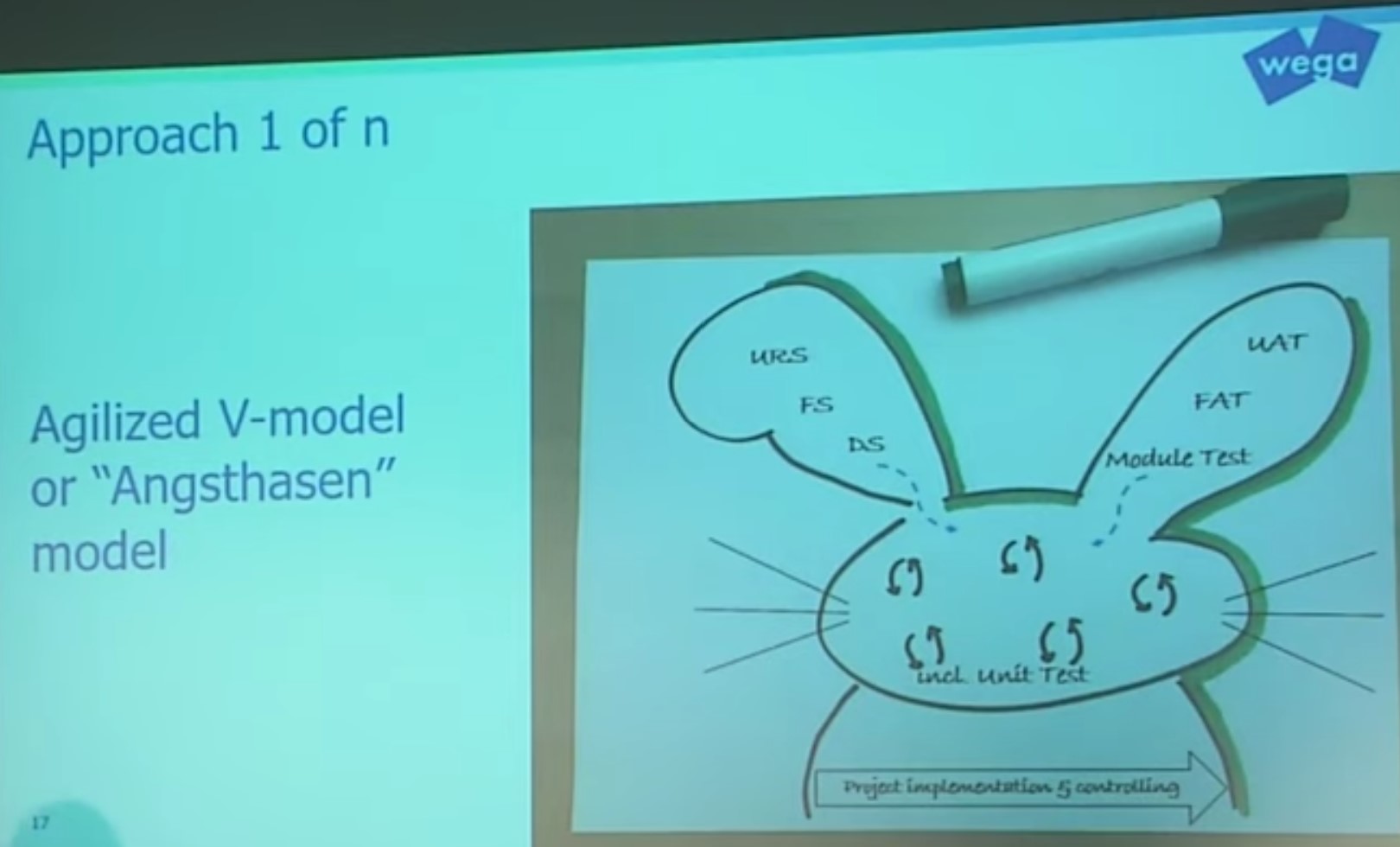On 4 June 2019 I followed an invitation to
wega-it’s Know-how & Networking Breakfast 2 2019 on “Agile Validation in GxP Projects”.
So they were to discuss Agility in the context of GxP regulation.
I had some earlier exposure to various kinds of compliance roles and topics, and my current work environment is in the highly regulated Pharma industry. So I was really wondering (and hoping for learning) how you can possibly bring the two points of view of Agility and GxP regulation together. The Literaturhaus Basel was to see some very special type of literature that day. Not a formal presentation but a role play performance between these two viewpoints, represented by Evelyne Daniel, an experienced GxP validation expert, and Mathias Fuchs, an equally experienced Scrum master, both from wega-IT. A very nice idea, very appropriate for the topic!
What is Compliance (GxP) and what is Agile?
Typically in GxP compliance we work along the so-called V-model. In its rigidness and wanted plannability of course it corresponds largely to the waterfall model of traditional software development. Opposed to this the Agile Manifesto (2001) criticizes the very basics of these traditional ways of working. Remember the iconic claims like “Working software over comprehensive Documentation” and “Responding to change over following a Plan”. But how would you ever get acceptance in the compliance world without full documentation and planning!?! When I quickly browsed the internet, I found a multitude of statements and proposals which would certainly merit a separate blog post. For this time, I will give a quick summary of the wega breakfast presentation and some touch points with our current working environment in the Pharma industry.
Although in my current work environment we are not actually driving GxP Validation projects, we are still subject to the very tight GxP regulation. In the processes of Change and Release Management, this is reflected in the rigid rules of testing and documentation, to just name the most obvious examples. Background, of course, is the definition of Compliance and its Validation: the goal is to “establish documented evidence” to assure compliance and quality etc. These requirements hold independently of the quality, completeness or even up-to-date status of the pre-defined processes and rules! Call this inflexible and cumbersome! Any adaptation (update!) of the processes and rules is very formal through the complicated administrative processes to be used and hence very slow. Consider this in our fast-moving (not only IT-) world!
What is an MVP?
A nice play of words was interjected in the stage discussion: the acronym MVP has a very clear meaning as a basic concept for both sides, just it is not the same: MVP = Master Validation Plan (in GxP Validation) versus Minimal Viable Product (in Agile or Lean Software Development).
How to bring them together?
Now how to bring the core aspirations of Agile Development like Customer focus, Flexibility, Speed into the Compliance world? A first inevitable step in the V-model world: break up the (dead?) lock between a complete finalization of User Requirements Specification and the setup of a complete Validation Plan prescribing all Qualification criteria (IQ, OQ, PQ). Definition of Done (DoD) plays a major role when trying to cut the end-to-end Development-Validation elephant into smaller pieces. Inclusion of Validation into the “daily” Development activities is another must, instead of adding Validation at the end of Development phases only. Yet another core principle from the Agile side is the ensurance of team Maturity and Mindset. Much-hailed Diversity is opposed to pure compliance-oriented expert teams, striving for innovation and creativity in the team.
Some basic approaches
The final answer on how to – methodically – combine or maybe rather “emulsify” Agility and Compliance Validation comes as no surprise: there is no one-size-fits-all method. Rather three obvious basic approaches were presented.
- introducing Agility right between the left (Specifications) and the right (Qualifications) arms of the V-model, probably using some kind of piloting or prototyping
- including Validation into the Agile Development, almost doing Validation in each Agile sprint
- appending V-model Validation at the end of an Agile development.
The above-mentioned end-to-end Development-to-Validation elephant has to be broken into smaller better manageable units. Each specific project situation will have its own possible and best way to do it.
Think innovative and creative!
Thanks to wega-informatik (www.wega-it.com) for organizing this creative and informative event.

![Thumbnail [60x60]](https://www.dbi-services.com/blog/wp-content/uploads/2022/05/Middleware-TO_Final-wpcf_173x250.png)
![Thumbnail [90x90]](https://www.dbi-services.com/blog/wp-content/uploads/2022/08/NME_web-min-scaled.jpg)
![Thumbnail [90x90]](https://www.dbi-services.com/blog/wp-content/uploads/2024/01/HME_web.jpg)
![Thumbnail [90x90]](https://www.dbi-services.com/blog/wp-content/uploads/2022/10/STS_web-min-scaled.jpg)